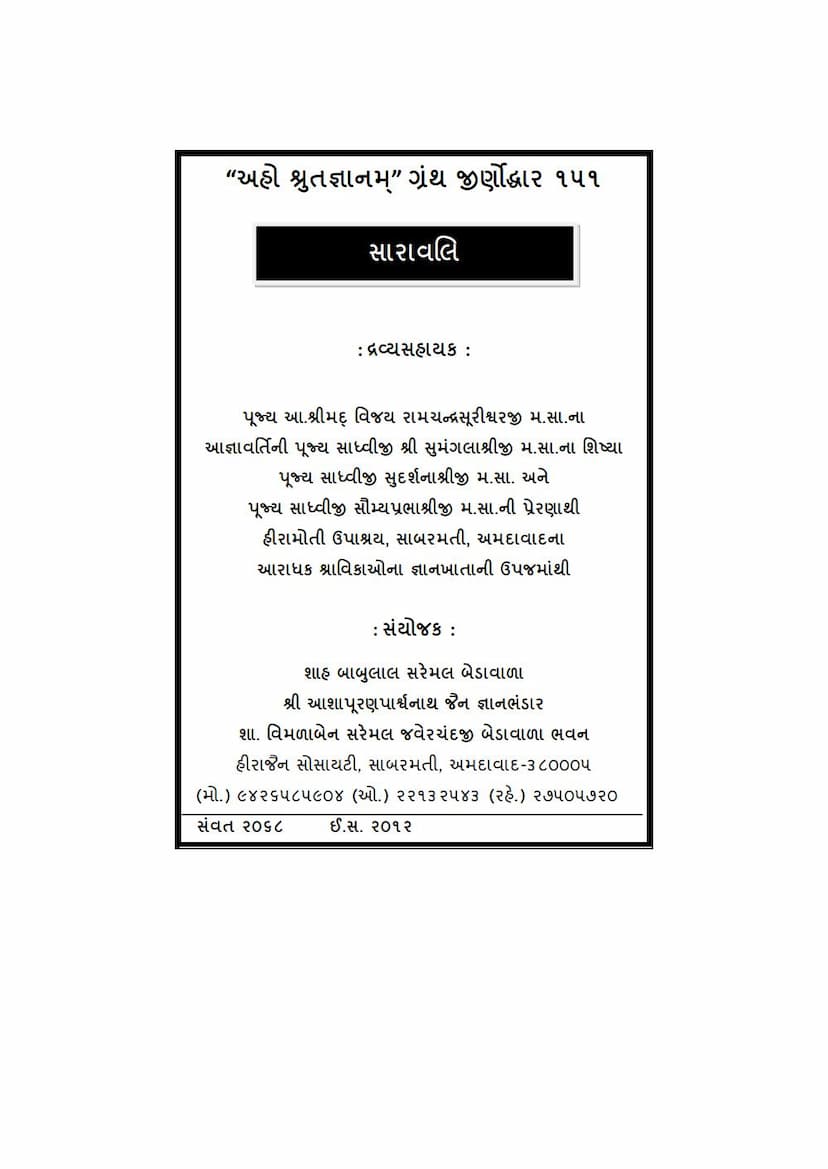Saravali
Added to library: September 2, 2025

Summary
Certainly! Based on the provided text, here's a comprehensive summary of the Jain text "Saravali":
Book Title: Saravali Author: Kalyanvarman Editor/Reviser: V. Subrahmanya Shastri Publisher: Pandurang Javji Publication Year (Third Edition): 1928
Overall Summary:
The Saravali is a significant classical text on Hindu astrology, compiled by Kalyanvarman and later edited and revised by V. Subrahmanya Shastri. The work is considered a foundational text in astrology, with its authority acknowledged by many later scholars and commentators, including Bhattotpala and Mallinatha. The author, Kalyanvarman, is believed to have flourished between the eras of Varahamihira and Bhattotpala. The book is known for its comprehensive coverage of astrological principles, providing detailed explanations and classifications related to planetary influences, birth charts, and predictions.
Key Contents and Themes:
The Saravali is structured into numerous chapters (adhyāyas), each focusing on specific aspects of astrology. The provided text outlines the chapter titles and provides extensive excerpts from the work, covering a wide range of topics:
-
Introduction and Fundamentals:
- Śāstrāvatāra (Introduction to the Science): Discusses the origin and purpose of astrological study.
- Horāśabdārthacintā (Meaning of the Term Horā): Explores the etymology and significance of the term "Horā" in astrology, relating it to the day and night cycle.
- Horārāśibheda (Classification of Horā and Rasis): Details the twelve zodiac signs (Rasis), their characteristics, and their association with different parts of the body. It also explains concepts like divisional charts and the significance of planetary positions within them.
- Graha yoni bheda (Distinction of Planetary Natures): Describes the inherent qualities, classifications (friendly, inimical, neutral), and directional influences of planets. It also discusses their associations with different elements, Vedas, and castes.
- Miśrakādhyāya (Mixed Chapter): Covers various astrological concepts not easily categorized, including the dignity of planets (dipta, svastha, mudita, etc.) and their resulting effects.
-
Planetary Influences and Combinations:
- Kārakādhyāya (Chapter on Karakas): Explains the significations (Karakas) of planets and their roles in determining life events.
- Ādhānādhyāya (Chapter on Conception): Discusses the astrological factors influencing conception and pregnancy.
- Sūtikādhyāya (Chapter on Childbirth): Details astrological considerations related to birth, including the physical characteristics and potential afflictions of the newborn based on planetary positions.
- Arishṭādhyāya (Chapter on Afflictions): Focuses on adverse astrological combinations that can lead to misfortune or premature death.
- Candrāriṣṭabhaṅgādhyāya (Remedies for Lunar Afflictions): Discusses ways to mitigate or overcome afflictions affecting the Moon.
- Candra vidhi (Rules regarding the Moon): Explains various yogas (planetary combinations) related to the Moon, such as Sunaphā, Anaphā, Durudharā, Viśākhā, and Ubhayacarī.
- Dvīgraha yoga (Two-planet combinations): Details the effects of conjunctions and aspects between pairs of planets.
- Trigraha yoga, Chaturgraha yoga, Pañcagraha yoga, Shaṭgraha yoga (Combinations of three, four, five, and six planets): Elaborates on the astrological outcomes of these more complex planetary groupings.
- Nābhasa yogas (Celestial Yogas): Discusses specific yogas formed by planetary positions in relation to the houses.
-
Specific Yogass and Predictions:
- Rājayoga (Royal Combinations): Focuses on yogas that indicate royal status, power, and influence.
- Pañcamahāpuruṣa yogas (Yogas of Five Great Men): Details the specific yogas formed by the planets Mars, Mercury, Jupiter, Venus, and Saturn in exaltation or their own houses.
- Āyurdāyādhyāya (Chapter on Longevity): Discusses methods for calculating the lifespan of an individual.
- Daśāntardāsa phalam (Results of Main and Sub-periods): Explains how planetary periods and sub-periods influence life events.
- Daśāriṣṭa phalam (Afflictions during Planetary Periods): Details adverse results occurring during specific planetary periods.
- Niryāṇa phalam (Results of Death): Discusses astrological indications of the time and manner of death.
- Naṣṭajātaka (Lost Horoscopes): Addresses methods for determining astrological placements when the birth time is unknown.
- Aṣṭakavarga (Ashtakavarga): Details the system of Ashtakavarga, a method of assessing planetary strength and predicting results based on beneficial points.
-
Additional Topics:
- Vṛddhi Cintă (Consideration of Increase): Discusses factors related to growth and prosperity.
- Vṛddhi Yoga Phalam (Results of Increase Yogas): Explains the outcomes of specific yogas leading to increase.
- Vṛddhi Phalam (Results of Increase): General principles of increase in life events.
- Nasta Jataka (Lost Horoscopes): Further elaboration on techniques for rectifying birth charts.
- Astakavarga (Ashtakavarga): Detailed principles and applications of the Ashtakavarga system.
The extensive list of chapters and their topics indicates the Saravali's encyclopedic nature, aiming to provide a comprehensive guide to astrological interpretation. The text emphasizes the interconnectedness of celestial influences and earthly events, offering insights into destiny, character, and life circumstances. The provided content also highlights the publisher's effort to preserve and disseminate ancient Indian knowledge through scanning and creating digital formats of old books.